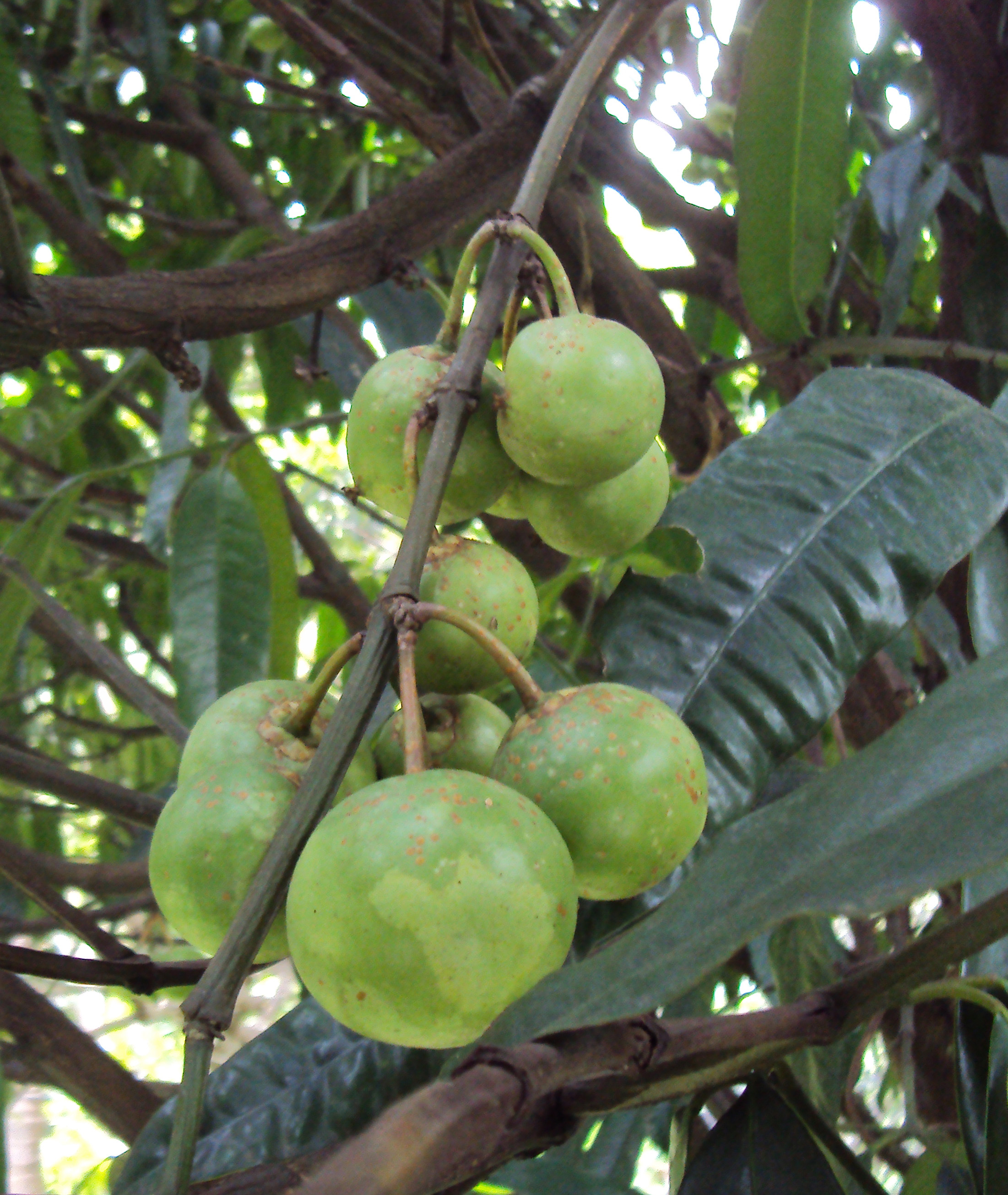|
Garcinia
''Garcinia'' is a genus of flowering plants in the family Clusiaceae native to Asia, America, Australia, tropical and southern Africa, and Polynesia. The number of species is disputed; Plants of the World Online (POWO) recognise up to 400. Commonly, the plants in this genus are called saptrees, mangosteens (which may also refer specifically to ''Garcinia mangostana''), garcinias, or monkey fruit. Many species are threatened by habitat destruction, and at least one species, '' G. cadelliana'', from South Andaman Island, is almost or even completely extinct already. The fruits are a food source for several animals, such as the archduke butterflies (''Lexias'' spp.) of tropical eastern Asia which relish the sap of overripe mangosteens. The genus is named after French botanist Laurent Garcin (1683–1751). Description ''Garcinia'' species are evergreen trees and shrubs, dioecious and in several cases apomictic. The fruit is a berry with fleshy endocarp, which in several species ... [...More Info...] [...Related Items...] OR: [Wikipedia] [Google] [Baidu] |
Garcinia Mangostana
Mangosteen (''Garcinia mangostana''), also known as the purple mangosteen, is a tropical evergreen tree with edible fruit native to tropical lands surrounding the Indian Ocean. Its origin is uncertain due to widespread prehistoric cultivation. It grows mainly in Southeast Asia, southwest India and other tropical areas such as Colombia and Puerto Rico, where the tree has been introduced. The tree grows from tall. The fruit of the mangosteen is sweet and tangy, juicy, somewhat fibrous, with fluid-filled vesicles ( like the flesh of citrus fruits), with an inedible, deep reddish-purple colored rind ( exocarp) when ripe. In each fruit, the fragrant edible flesh that surrounds each seed is botanically endocarp, i.e., the inner layer of the ovary.Mabberley, D.J. 1997. The plant book: A portable dictionary of the vascular plants. Cambridge University Press, Cambridge. The seeds are of similar size and shape to almonds. Genus '' Garcinia'' also contains several less known fruit-bearin ... [...More Info...] [...Related Items...] OR: [Wikipedia] [Google] [Baidu] |
Garcinia Subelliptica
''Garcinia subelliptica'', commonly known as the happiness or Fukugi tree, is an evergreen tree found in coastal forests of East and Southeast Asia, specifically the Ryukyu Islands of Japan, Taiwan, Philippines, Indonesia, Sri Lanka, and India. Trees are 6–20 meters high with ovate-oblong or elliptical thick leathery leaves. Fruits are smooth and yellow with 1-4 seeds. The tree is widely planted in the Ryukyu Islands as a windbreak and ornamental, and the bark is a traditional dye. It is the floral emblem In a number of countries, plants have been chosen as symbols to represent specific geographic areas. Some countries have a country-wide floral emblem; others in addition have symbols representing subdivisions. Different processes have been used to ... for the towns of Motobu and Tarama. References External links * *Garcinia Cambogia Benefits {{Taxonbar, from=Q11333052 subelliptica Taxa named by Elmer Drew Merrill ... [...More Info...] [...Related Items...] OR: [Wikipedia] [Google] [Baidu] |
Garcinia Cadelliana
''Garcinia cadelliana'' is a critically endangered species of small tree in the family Clusiaceae found only on the South Andaman Island of India India, officially the Republic of India (Hindi: ), is a country in South Asia. It is the seventh-largest country by area, the second-most populous country, and the most populous democracy in the world. Bounded by the Indian Ocean on the so .... References Flora of the Andaman Islands cadelliana Taxonomy articles created by Polbot {{Clusiaceae-stub ... [...More Info...] [...Related Items...] OR: [Wikipedia] [Google] [Baidu] |
Clusiaceae
The Clusiaceae or Guttiferae Juss. (1789) (''nom. alt. et cons.'' = alternative and valid name) are a family (biology), family of plants including 13 genera and ca 750 species. Several former members of Clusiacae are now placed in Calophyllaceae and Hypericaceae. They are mostly trees and shrubs, with milky sap and fruits or capsule (fruit), capsules for seeds. The family is primarily tropical. More so than many plant families, it shows large variation in plant morphology (for example, three to 10, fused or unfused petals, and many other traits). According to the Angiosperm Phylogeny Group, APG III, this family belongs to the order Malpighiales. One feature which is sometimes found in this family, and rarely in others (e.g., Malpighiaceae), is providing pollinators with rewards other than pollen or nectar; specifically, some species offer resin which bees use in nest construction (all three rewards are found in different species of the Clusiaceae). Taxonomic history The family ... [...More Info...] [...Related Items...] OR: [Wikipedia] [Google] [Baidu] |
Monkey Fruit
Monkey fruit is a common name for several plants and can refer to some species in the following genera: *''Artocarpus'', particularly ''Artocarpus lacucha'' and '' Artocarpus rigidus'' *''Garcinia ''Garcinia'' is a genus of flowering plants in the family Clusiaceae native to Asia, America, Australia, tropical and southern Africa, and Polynesia. The number of species is disputed; Plants of the World Online (POWO) recognise up to 400. Common ...'', particularly '' Garcinia intermedia'' *'' Limonia'' *'' Myrianthus'' References [...More Info...] [...Related Items...] OR: [Wikipedia] [Google] [Baidu] |
Apomictic
In botany, apomixis is asexual reproduction without fertilization. Its etymology is Greek for "away from" + "mixing". This definition notably does not mention meiosis. Thus "normal asexual reproduction" of plants, such as propagation from cuttings or leaves, has never been considered to be apomixis, but replacement of the seed by a plantlet or replacement of the flower by bulbils were categorized as types of apomixis. Apomictically produced offspring are genetically identical to the parent plant. Some authors included all forms of asexual reproduction within apomixis, but that generalization of the term has since died out. In flowering plants, the term "apomixis" is commonly used in a restricted sense to mean agamospermy, i.e., clonal reproduction through seeds. Although agamospermy could theoretically occur in gymnosperms, it appears to be absent in that group. Apogamy is a related term that has had various meanings over time. In plants with independent gametophytes (notably ... [...More Info...] [...Related Items...] OR: [Wikipedia] [Google] [Baidu] |
Archduke (butterfly)
The archdukes are a genus, ''Lexias'', of tropical forest-dwelling butterflies that are common throughout Southeast Asia and Australasia. Members of the brush-footed butterfly family Nymphalidae, the genus is represented by about 17 species. Two very similar and coexisting genera are ''Tanaecia''_(the_viscounts_and_earls)_and_''Euthalia.html" ;"title="869]"at Markku Savela's ''Lepidoptera and Some Other Life Forms'' *''Tanaecia amisa'' G ...'' (the viscounts and earls) and ''Euthalia">869]"at Markku Savela's ''Lepidoptera and Some Other Life Forms'' *''Tanaecia amisa'' G ...'' (the viscounts and earls) and ''Euthalia'' (the barons and counts), the latter previously including some ''Lexias'' species. The largest species reach a wingspan of about . Description '' Lexias pardalis'' and '' L. dirtea'' are also among the most colourful archdukes. Sexual dimorphism, Sexual dichromatism is however extreme, with the two sexes appearing entirely different. The males' dorsal wing ... [...More Info...] [...Related Items...] OR: [Wikipedia] [Google] [Baidu] |
Species
In biology, a species is the basic unit of classification and a taxonomic rank of an organism, as well as a unit of biodiversity. A species is often defined as the largest group of organisms in which any two individuals of the appropriate sexes or mating types can produce fertile offspring, typically by sexual reproduction. Other ways of defining species include their karyotype, DNA sequence, morphology, behaviour or ecological niche. In addition, paleontologists use the concept of the chronospecies since fossil reproduction cannot be examined. The most recent rigorous estimate for the total number of species of eukaryotes is between 8 and 8.7 million. However, only about 14% of these had been described by 2011. All species (except viruses) are given a two-part name, a "binomial". The first part of a binomial is the genus to which the species belongs. The second part is called the specific name or the specific epithet (in botanical nomenclature, also sometimes i ... [...More Info...] [...Related Items...] OR: [Wikipedia] [Google] [Baidu] |
Dioecious
Dioecy (; ; adj. dioecious , ) is a characteristic of a species, meaning that it has distinct individual organisms (unisexual) that produce male or female gametes, either directly (in animals) or indirectly (in seed plants). Dioecious reproduction is biparental reproduction. Dioecy has costs, since only about half the population directly produces offspring. It is one method for excluding self-fertilization and promoting allogamy (outcrossing), and thus tends to reduce the expression of recessive deleterious mutations present in a population. Plants have several other methods of preventing self-fertilization including, for example, dichogamy, herkogamy, and self-incompatibility. Dioecy is a dimorphic sexual system, alongside gynodioecy and androdioecy. In zoology In zoology, dioecious species may be opposed to hermaphroditic species, meaning that an individual is either male or female, in which case the synonym gonochory is more often used. Most animal species are dioeci ... [...More Info...] [...Related Items...] OR: [Wikipedia] [Google] [Baidu] |
Shrub
A shrub (often also called a bush) is a small-to-medium-sized perennial woody plant. Unlike herbaceous plants, shrubs have persistent woody stems above the ground. Shrubs can be either deciduous or evergreen. They are distinguished from trees by their multiple stems and shorter height, less than tall. Small shrubs, less than 2 m (6.6 ft) tall are sometimes termed as subshrubs. Many botanical groups have species that are shrubs, and others that are trees and herbaceous plants instead. Some definitions state that a shrub is less than and a tree is over 6 m. Others use as the cut-off point for classification. Many species of tree may not reach this mature height because of hostile less than ideal growing conditions, and resemble a shrub-sized plant. However, such species have the potential to grow taller under the ideal growing conditions for that plant. In terms of longevity, most shrubs fit in a class between perennials and trees; some may only last about fiv ... [...More Info...] [...Related Items...] OR: [Wikipedia] [Google] [Baidu] |
Tree
In botany, a tree is a perennial plant with an elongated stem, or trunk, usually supporting branches and leaves. In some usages, the definition of a tree may be narrower, including only woody plants with secondary growth, plants that are usable as lumber or plants above a specified height. In wider definitions, the taller palms, tree ferns, bananas, and bamboos are also trees. Trees are not a taxonomic group but include a variety of plant species that have independently evolved a trunk and branches as a way to tower above other plants to compete for sunlight. The majority of tree species are angiosperms or hardwoods; of the rest, many are gymnosperms or softwoods. Trees tend to be long-lived, some reaching several thousand years old. Trees have been in existence for 370 million years. It is estimated that there are some three trillion mature trees in the world. A tree typically has many secondary branches supported clear of the ground by the trunk. This trunk typicall ... [...More Info...] [...Related Items...] OR: [Wikipedia] [Google] [Baidu] |
Evergreen
In botany, an evergreen is a plant which has foliage that remains green and functional through more than one growing season. This also pertains to plants that retain their foliage only in warm climates, and contrasts with deciduous plants, which completely lose their foliage during the winter or dry season. Evergreen species There are many different kinds of evergreen plants, both trees and shrubs. Evergreens include: *Most species of conifers (e.g., pine, hemlock, blue spruce, and red cedar), but not all (e.g., larch) *Live oak, holly, and "ancient" gymnosperms such as cycads *Most angiosperms from frost-free climates, and rainforest trees *All Eucalypts * Clubmosses and relatives * Bamboos The Latin binomial term , meaning "always green", refers to the evergreen nature of the plant, for instance :'' Cupressus sempervirens'' (a cypress) :''Lonicera sempervirens'' (a honeysuckle) :''Sequoia sempervirens'' (a sequoia) Leaf longevity in evergreen plants varies from a ... [...More Info...] [...Related Items...] OR: [Wikipedia] [Google] [Baidu] |








